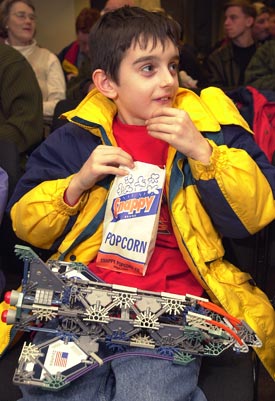‘War of the Worlds’ wows again
Sci-Fi Movie Night a campy hit with the community

Martians battled humanity at the Harvard-Smithsonian Center for Astrophysics (CfA) Thursday night (March 7), and, to the delight of a partisan home crowd, the humans won.
In truth, it wasn’t a fair fight, however. The Martians had the humans licked until bacteria weighed in on the human side. Given how many battles we humans have had ourselves with bacteria, it was a strange alliance. But the enemy of my enemy is my friend, eh?
No matter though, a good time was had by all (except, perhaps, the Martians) at the Harvard-Smithsonian Center for Astrophysics’ monthly Sci-Fi Movie Night, featuring a showing of the 1953 version of H.G. Wells’ “War of the Worlds.”
Sci Fi Movie Night is a monthly community outreach program that has so far reached about all the community that can fit in the seats of the CfA’s Phillips Auditorium. On Thursday, the packed house was treated not only to a free movie, but also free popcorn, a free Flash Gordon episode, and a free lecture about today’s science concerning life on other planets (probably) and the chance of it still existing on Mars (probably not).
The audience got to experience all this at one of the world’s premier astrophysical research institutions in a building with an observatory on the roof.
Cool.
“[It] has been just a marvelous surprise,” said David Aguilar, the CfA’s manager of public affairs. “It’s just grown by world of mouth.”

Aguilar said he got the idea for the program when he was watching television, but not from old movies. He got the idea from commercials.
“It was kind of a whim of an idea that we had. I was watching television commercials where the science was so, so wrong,” Aguilar said. “And so many people say they learn much of their science from TV.”
So Sci-Fi Movie Night was born. Beginning last fall, the program couples a lecture on the actual science behind a movie concept with a showing of a classic sci-fi flick. The event attracts people from all over, Aguilar said, from Harvard students to members of the community. On Thursday, Alison Hanrahan from Dorchester said she was making up for lost time since she’d never seen “War of the Worlds” before. She said showing the movies at the observatory is a great way to get people in to see the show.
“It’s awesome,” said Hanrahan, an avowed Star Trek junkie. “And the price is right.”
Previous showings have featured such standards as “The Day the Earth Stood Still” and the original “Invasion of the Body Snatchers,” which was introduced by famed Harvard biologist Edward O. Wilson.
On Thursday, Roy Gould, of the CfA’s Science Education Department, brought the audience up to speed on the current thinking about extraterrestrial life. But first he brought himself up to speed on the audience’s thinking. In a show of hands, the audience told Gould they almost unanimously believe that life is out there – somewhere. Gould, in turn, indicated that the scientific community increasingly agrees with them.
Scientists have found a likely candidate for life in our solar system outside Earth, Gould said, but it’s not Mars. The likeliest candidate is Jupiter’s second moon, Europa, which scientists believe is covered with a saltwater ocean 60 miles deep that is warmed by Jupiter’s gravitational tug on the moon to the temperature of the waters off Bermuda.
The problem, Gould said, is that Europa is not necessarily the easiest place to find life, since it’s surrounded by a thick layer of ice that scientists don’t yet know how to drill through.
“It’s probably the most likely place for there to be life, possibly large life,” Gould said. “On the other hand, Europa is not a likely place to detect life because nobody knows how to drill through the ice.”
The likeliest place to actually find life – or evidence of past life – is the star of Thursday’s movie, Mars, which scientists believe was once a much warmer, wetter, and generally friendlier place for life.
Other possibilities are planets in orbit around other stars. Gould said more than 100 have been found already, and improving technology should make it a matter of time before astronomers can see not just the gas giants so far detected, but smaller planets like ours.
“It’s only a matter of time before astronomers detect for the first time the pale blue dot – the Holy Grail for astronomers, the Earth-like planet,” Gould said. “We are likely the first generation that will find out for the first time whether there’s life outside Earth.”
Until that happens, our imaginations – and the April 13 showing of “Devil Girl from Mars,” of course – will have to suffice.
For more information on the Sci-Fi Movie night, check out the CfA Web site http://cfa-www.harvard.edu/cfa/ep/movie_night.html




